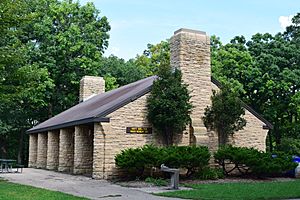Frank W. Hoyt Park facts for kids
Quick facts for kids Frank W. Hoyt Park |
|
|---|---|

A shelter in the park.
|
|
| Location | 3902 Regent St., 90 & 91 Owen Pkwy. Madison, Wisconsin |
| Area | 22.63 acres (9.16 ha) |
|
Frank W. Hoyt Park
|
|
| NRHP reference No. | 100002815 |
| Added to NRHP | August 17, 2018 |
Frank W. Hoyt Park is a lovely green space found in Madison, Wisconsin. This park has an interesting past, as it was formed from two different pieces of land that were joined together. Today, it's a popular spot for people to enjoy nature and relax.
Contents
The Story of Hoyt Park
How the Park Began
A Stone Quarry and a Professor's Land
Frank W. Hoyt Park wasn't always one big park. It started as two separate areas back in the 1800s. One part, which was more than 20 acres, used to be a place where people dug for stone. This was called a quarry. The City of Madison bought this quarry in 1890.
The other part of the park belonged to a professor named Edward T. Owen. He taught at the University of Wisconsin–Madison. Professor Owen later gave his land to a local group that cared for parks. This area became known as Owen Parkway.
Joining Forces for a New Park
More land was also given by Frank W. Hoyt. He was a very important person in the local parks group. Eventually, the city decided to close down the stone quarry. The two separate areas, the old quarry and Owen Parkway, were then combined. This new, larger public park was later named after Frank W. Hoyt.
Park Improvements and Recognition
Building During Tough Times
During the Great Depression, a time when many people didn't have jobs, special government programs helped improve the park. Groups like the Civil Works Administration and the Works Progress Administration built several structures and pathways in the park. This helped create jobs and made the park even better for everyone.
A Place of History
In 2018, Frank W. Hoyt Park received a special honor. It was added to both the State and the National Register of Historic Places. This means the park is recognized as an important historical site.

